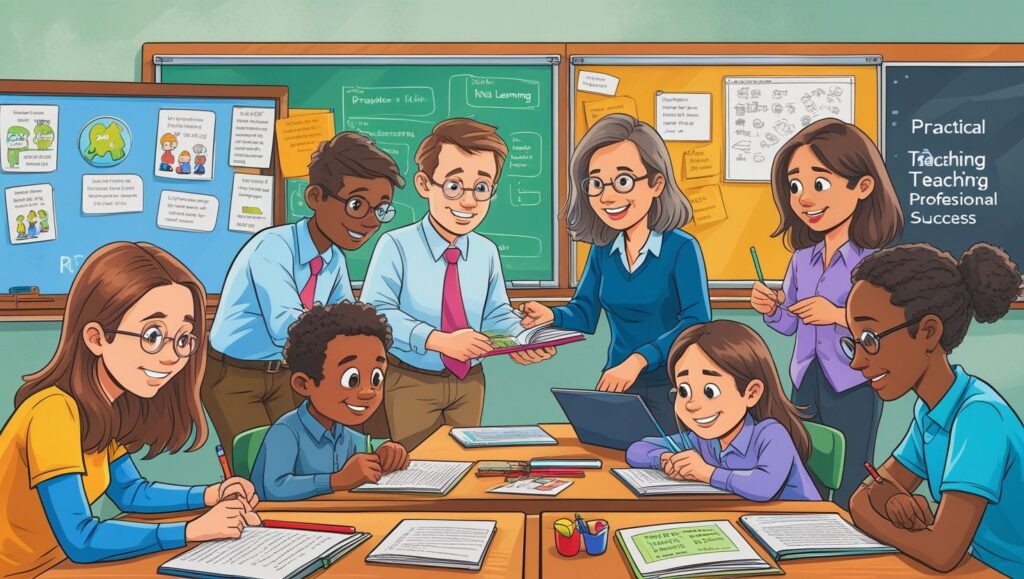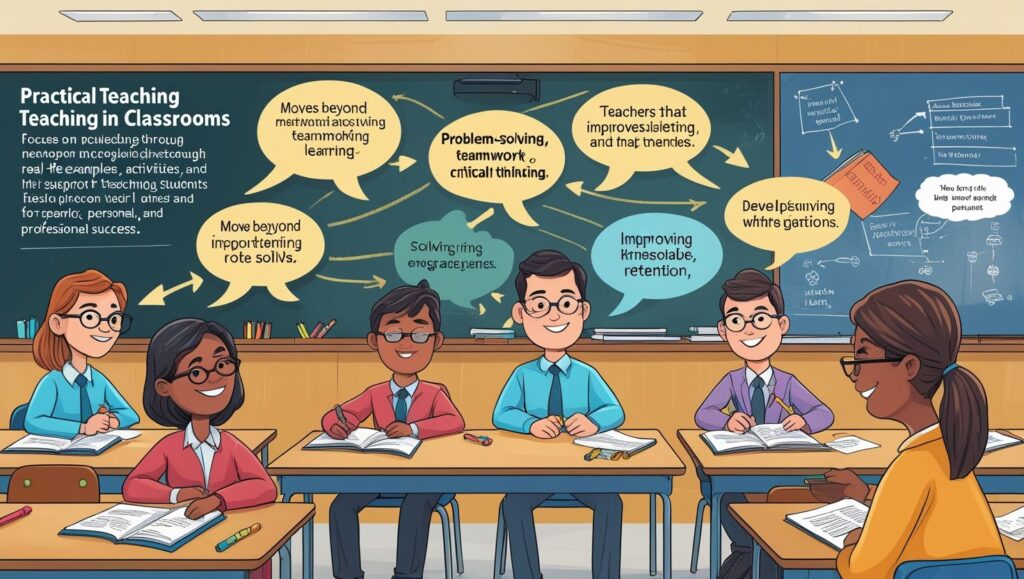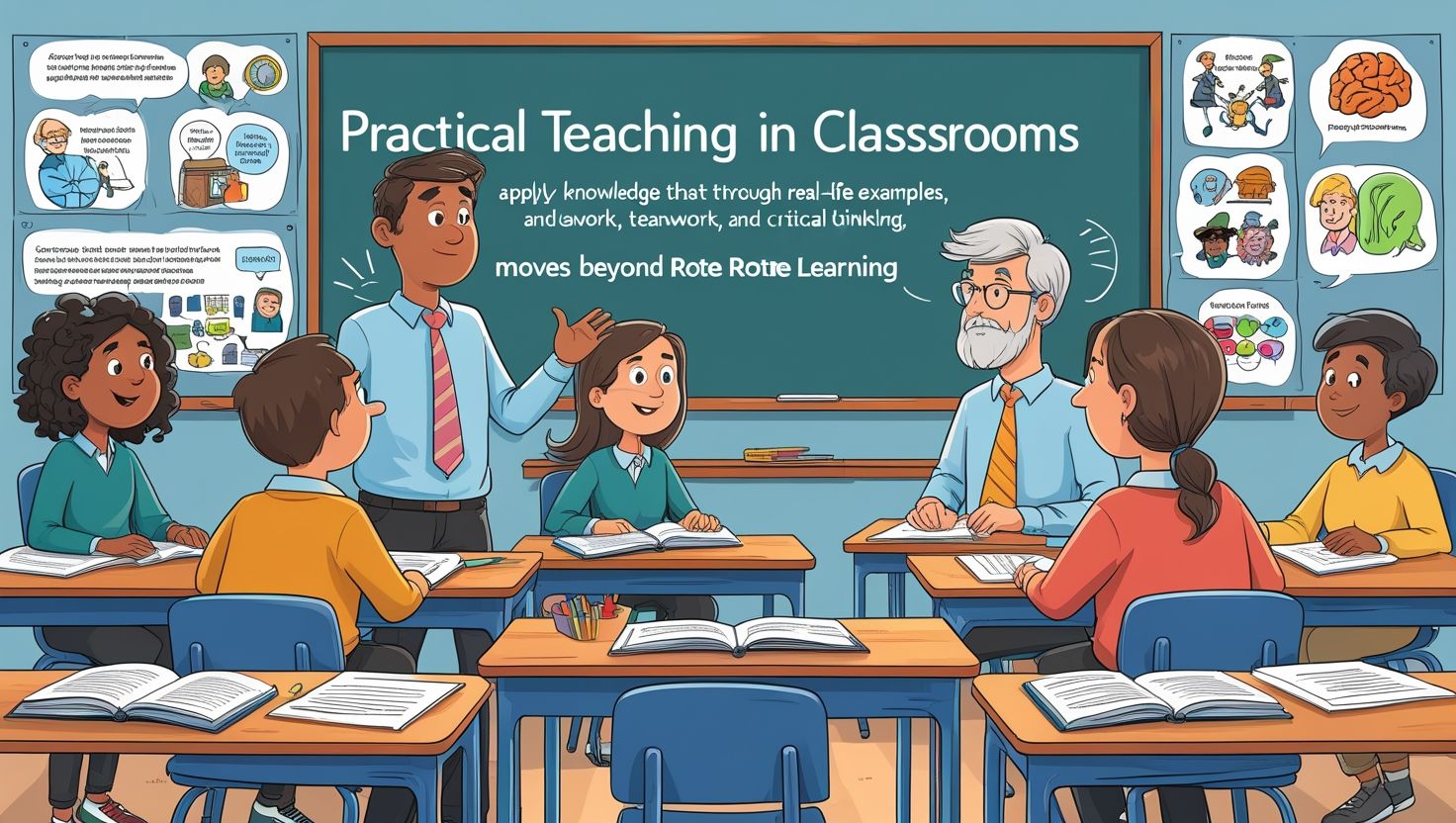Introduction
Practical teaching in classrooms is an instructional method that emphasizes the direct application of knowledge, skills, and concepts. Rather than depending only on lectures or textbooks, this approach integrates hands-on experiences and real-life examples. Students become more involved in their learning when they connect theory with practice. Moreover, practical teaching encourages collaboration, experimentation, and problem-solving. It builds confidence among learners because they see immediate results from their efforts. In addition, it develops critical thinking and adaptability. Teachers who adopt this approach create more engaging and meaningful lessons. Practical teaching also caters to different learning styles, making it highly inclusive. Visual, auditory, and kinesthetic learners can all benefit from such methods. Furthermore, it reduces passive learning and transforms classrooms into dynamic spaces. Therefore, practical teaching is widely seen as a bridge between academic learning and life outside school. It is an approach that enhances both knowledge and skills.
Importance of Practical Teaching
Practical teaching holds great significance in education. It ensures that learning is not limited to abstract concepts but becomes something learners can apply in everyday situations. Students who experience practical lessons are more motivated and engaged. Furthermore, they retain information longer since knowledge is linked with action. Practical teaching also prepares learners for professional life, where skills are valued alongside theoretical understanding. Teachers who apply practical methods help students to connect curriculum content with real-world challenges. Additionally, this approach enhances problem-solving abilities because students must think critically and find solutions. It also builds teamwork, communication, and responsibility among learners. Moreover, practical teaching fosters creativity by allowing students to experiment with ideas and approaches. It addresses the limitations of traditional rote learning and makes education more meaningful. As a result, students become independent thinkers who can transfer their learning to new contexts. Therefore, practical teaching is vital for holistic education.
Characteristics of Practical Teaching
Practical teaching is defined by several important characteristics. Firstly, it focuses on active participation rather than passive reception. Students engage in tasks that demand their involvement and decision-making. Secondly, it connects classroom activities with real-life applications, making learning more meaningful. Thirdly, it encourages creativity and innovation by giving learners freedom to explore. Furthermore, practical teaching involves problem-based learning, where students tackle challenges and propose solutions. It also highlights collaboration, since many activities are group-based. Teachers play the role of facilitators, guiding rather than dictating. Another key characteristic is inclusivity, because practical teaching suits multiple learning styles. Moreover, this approach provides immediate feedback, allowing learners to see the results of their efforts. It also uses diverse tools, such as experiments, projects, simulations, and discussions. Importantly, practical teaching fosters independence, as students learn to manage tasks themselves. Altogether, these characteristics make practical teaching a comprehensive and learner-centered method.

Methods of Practical Teaching
Several methods are widely used to implement practical teaching. One popular approach is project-based learning, where students work on tasks over time and present results. Another method is role-playing, which helps learners practice real-life situations in controlled environments. Experiments in science subjects also provide direct experiences. Additionally, group discussions and debates encourage critical thinking and communication. Teachers may use case studies to connect theory with practical examples. Simulations and models also bring abstract ideas to life. Field trips and community-based activities extend learning beyond the classroom walls. Furthermore, problem-solving exercises teach students to apply logic and reasoning. Technology also supports practical teaching, as digital tools and interactive platforms make lessons more engaging. Moreover, collaborative learning fosters teamwork and social skills. Each method not only teaches knowledge but also develops essential life skills. By blending these methods, teachers make classrooms more effective and student-centered.
Role of Teachers in Practical Teaching
Teachers play a central role in practical teaching. They act as facilitators who guide students rather than control the entire learning process. Teachers create meaningful activities that link theory with application. Additionally, they encourage learners to take responsibility for their own progress. Teachers also design tasks that are challenging yet achievable, which promotes confidence. Furthermore, they monitor group interactions and ensure fairness in collaboration. Teachers must also provide clear instructions and constructive feedback. Their role extends to managing classroom resources and time effectively. Moreover, teachers inspire creativity by giving students the freedom to try new approaches. They also evaluate practical outcomes fairly, balancing both effort and results. Importantly, teachers model problem-solving and critical thinking skills themselves. In addition, they build an inclusive environment where all learners can participate. Therefore, teachers in practical classrooms are not only instructors but also mentors and guides. Their role is crucial for success.
Role of Students in Practical Teaching
Students also play an essential role in practical teaching. They are not passive listeners but active participants. Their responsibility is to engage fully in activities, discussions, and experiments. Furthermore, students must cooperate with peers during group tasks. They also need to practice problem-solving skills by applying concepts in new ways. Practical teaching demands curiosity, so students must ask questions and seek answers. Moreover, learners should take initiative in exploring beyond the classroom. Self-discipline and responsibility are equally important, as many tasks require independent effort. In addition, students must be open to feedback and willing to improve. They should also develop creativity by trying different methods of completing tasks. Importantly, students must respect others’ opinions during discussions and collaborative projects. Practical teaching empowers them to become decision-makers and critical thinkers. Therefore, their active role determines how successful practical teaching can be. Engagement and commitment are vital for effective learning.

Advantages of Practical Teaching
Practical teaching offers numerous advantages for both learners and educators. Firstly, it makes learning engaging and interactive, which increases motivation. Secondly, it improves retention because knowledge is applied rather than memorized. Thirdly, it develops essential life skills such as communication, teamwork, and problem-solving. Furthermore, practical teaching builds confidence as students see the results of their efforts. It also bridges the gap between theory and practice, preparing learners for real-life situations. Moreover, it accommodates diverse learning styles, making classrooms more inclusive. Teachers also benefit since practical activities often reduce monotony and create dynamic environments. Additionally, students become more independent and self-directed in their learning. Practical teaching also stimulates creativity, as learners experiment with different methods. Another advantage is the immediate feedback students receive, which enhances their progress. Altogether, this approach creates well-rounded learners who are prepared for both academic and professional challenges. Therefore, its advantages are far-reaching.
Challenges of Practical Teaching
Although practical teaching is beneficial, it also presents challenges. One major issue is time management, as activities may take longer than planned. Teachers often struggle to balance curriculum coverage with hands-on tasks. Furthermore, practical teaching requires more resources, which are not always available. Limited materials and facilities can restrict opportunities for experiments or projects. Additionally, large class sizes make group management difficult. Some students may dominate discussions while others remain passive. Teachers also need additional training to design and implement effective practical lessons. Moreover, assessment of practical work is more complex compared to written tests. Safety concerns may also arise, especially in laboratories or fieldwork. Furthermore, some learners resist active participation due to shyness or lack of confidence. Technology-based practical methods may face issues of access and cost. Despite these challenges, practical teaching remains valuable. Teachers must find creative solutions to overcome these barriers and ensure effectiveness.

Practical Teaching and Technology
Technology plays a vital role in advancing practical teaching. Digital tools such as simulations, interactive software, and virtual labs provide innovative ways to apply concepts. Furthermore, multimedia presentations make abstract ideas easier to understand. Online platforms also support collaboration through shared documents and group discussions. Moreover, e-learning resources allow students to practice skills beyond the classroom. Virtual reality and augmented reality create immersive experiences that bring lessons to life. Teachers can also use technology for instant assessments and feedback. Additionally, digital games and apps promote interactive and enjoyable learning. However, effective use of technology requires proper training and infrastructure. Not all schools have equal access to resources, which may create a gap. Nevertheless, when integrated well, technology enhances practical teaching significantly. It connects learners with global knowledge and real-world applications. Therefore, technology should be seen as a powerful partner in modern practical teaching methods.
Future of Practical Teaching
The future of practical teaching looks promising as education continues to evolve. Schools worldwide are recognizing the need to balance theory with practice. As industries demand skilled professionals, practical teaching will gain greater importance. Furthermore, new technologies will continue to transform classrooms. Virtual labs, artificial intelligence, and online platforms will provide more opportunities for applied learning. Teachers will adopt blended approaches that combine traditional instruction with practical activities. Moreover, student-centered learning will dominate, giving learners more responsibility for their growth. Practical teaching will also emphasize sustainability, creativity, and social responsibility. Additionally, lifelong learning skills will be prioritized, preparing students for continuous growth. Global collaboration will expand through digital tools, offering real-world perspectives. Although challenges like resources and training remain, innovative solutions will emerge. Overall, the future of practical teaching will strengthen education by creating adaptable, skilled, and critical thinkers. Therefore, it will remain central to effective learning.
Conclusion
Practical teaching in classrooms is more than a method; it is a philosophy of learning that connects theory with application. It enhances engagement, retention, and life skills among students. Teachers act as facilitators, while learners become active participants. Although challenges such as time, resources, and assessment exist, the benefits outweigh the obstacles. Moreover, the integration of technology is making practical teaching even more powerful. The future points toward greater reliance on applied learning methods. As education moves forward, practical teaching will ensure that students not only acquire knowledge but also know how to use it effectively. It prepares them for academic success, personal development, and professional readiness. Therefore, practical teaching is essential for building well-rounded individuals who can thrive in a changing world. It transforms classrooms into places where knowledge is not just learned but also lived.

I believe that iis among the most important info for me. And i am
satisfied reading your article. However want to commentary onn few basic things,
The web site style is perfect, the articles is in poiknt of fact excellent : D.
Just right activity, cheers https://z42mi.mssg.me